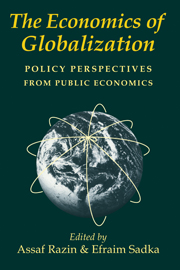Book contents
- Frontmatter
- Contents
- Preface
- List of Contributors
- Introduction
- I International Mobility of Technology
- II Capital Flows and Exchange-Rate Misalignment
- III Tax Incentives and Patterns of Capital Flows
- IV Limits to Income Redistribution in Federal Systems
- V Tax Harmonization, Tax Coordination, and the “Disappearing Taxpayer”
- 8 Is There a Need for a World Tax Organization?
- 9 Taxation, Financial Innovation, and Integrated Financial Markets: Some Implications for Tax Coordination in the European Union
- 10 Can International Commodity-Tax Harmonization Be Pareto-Improving When Governments Supply Public Goods?
- 11 Fiscal Separation with Economic Integration: Israel and the Palestinian Authority
- VI Political-Economy Aspects of International Tax Competition
- VII Migration of Skilled and Unskilled Labor
- VIII Fiscal Aspects of Monetary Unification
- Index
10 - Can International Commodity-Tax Harmonization Be Pareto-Improving When Governments Supply Public Goods?
Published online by Cambridge University Press: 28 January 2010
- Frontmatter
- Contents
- Preface
- List of Contributors
- Introduction
- I International Mobility of Technology
- II Capital Flows and Exchange-Rate Misalignment
- III Tax Incentives and Patterns of Capital Flows
- IV Limits to Income Redistribution in Federal Systems
- V Tax Harmonization, Tax Coordination, and the “Disappearing Taxpayer”
- 8 Is There a Need for a World Tax Organization?
- 9 Taxation, Financial Innovation, and Integrated Financial Markets: Some Implications for Tax Coordination in the European Union
- 10 Can International Commodity-Tax Harmonization Be Pareto-Improving When Governments Supply Public Goods?
- 11 Fiscal Separation with Economic Integration: Israel and the Palestinian Authority
- VI Political-Economy Aspects of International Tax Competition
- VII Migration of Skilled and Unskilled Labor
- VIII Fiscal Aspects of Monetary Unification
- Index
Summary
Introduction
Coordination of commodity taxes among the member countries of the European Union (EU) has been a policy issue since the mid-1980s. In 1987 the European Commission proposed that rates for value-added taxes (VATs) and excise taxes be harmonized to lie within certain bands. Those proposals were eventually implemented in modified form in 1993 as directives on minimum rates for VATs and excise taxes, but it is believed that harmonization remains a long-term policy objective of the commission (Bovenberg and Home, 1992). The harmonization proposals were aimed primarily at restricting the amount of cross-border shopping in the post–1992 “single market,” which the commission believed would reach unacceptable levels if tax-induced price differentials proved to be greater than 5% (Smith, 1992). However (especially as the extent of tax-induced cross-border shopping in the EU seems, in practice, to be rather small) (Fitzgerald, Johnston, and Williams, 1994), it is worth asking under what conditions harmonization can also yield benefits in a setting of commodity taxation that is fully destination-based (i.e., without taxinduced cross-border shopping).
In two influential papers, Keen (1987,1989) addressed this question. Assuming two countries in a customs union, and assuming that the countries had no tax-revenue requirements, he derived conditions under which a certain class of “harmonizing” commodity-tax reforms could either make both countries better off (an actual Pareto improvement) or at least allow the gainer to compensate the loser (a potential Pareto improvement).
- Type
- Chapter
- Information
- The Economics of GlobalizationPolicy Perspectives from Public Economics, pp. 222 - 245Publisher: Cambridge University PressPrint publication year: 1999
- 1
- Cited by



